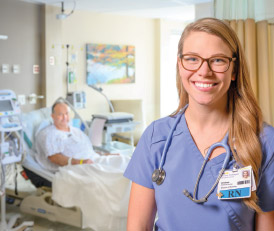MedStar Heart & Vascular Institute’s (MHVI) highly trained cardiovascular nurses are at the heart of successful outcomes
This spring, for instance, MedStar Washington Hospital Center’s nursing educators are beginning a new class for cardiovascular nurses: a four-hour breakout session focused exclusively on vascular nursing. “Courses like this one were developed to complement the already extensive cardiovascular education that our nurses experience,” says Nancy Bruce, vice president at MHVI.
The vascular course, one ofthe first such training programs in the country, covers the unique technology and interventions used in specialty vascular procedures in the heart’s periphery. It fills a unique need: supporting specialized nursing expertise to manage the rapid growth of cardiovascular patients at the MedStar Heart & Vascular Institute.
Four Months of Training and 12 Months of Additional Hands-on Orientation
Developed by critical care educators in the Hospital Center’s Nursing Professional Development Department, the new vascular class builds upon four months of training and an additional 12 months of support with experienced preceptors through the nurse residency program, already required for nurses who become part of MHVI. “The cardiologists and surgeons rely on input from the nurses to assess and develop the plan of care,” says Lucy Shivnan, BSN, RN, one of the critical care educators who train MHVI nurses. “Cardiovascular nurses need to delve deeper into catheters, pacing and goals of care for the cardiac patient population, and the complications that are typical in this area. We layer more complexity as we go.”
In addition to classroom didactic, nurses in the training program use skills simulation to learn such procedures as attaching temporary pacing wires to the heart to make it beat regularly or faster after surgery.
Nurses in MHVI procedural areas have similar training and expertise. At MHVI’s Cardiovascular Lab at MedStar Union Memorial Hospital, nurses specialize in one of three areas, and training can take three to six months, notes Kathleen Wenham, RN, manager of Patient Care Services. Nurses in the Lab “require a background in critical care or emergency nursing before they are hired,” she says.
Learn Quickly, Desire to Excel
MHVI nurses also participate in research that involves technologies, medications, and procedures not available elsewhere. “The MHVI nurse needs to learn quickly, be open and curious to learning new information constantly, be willing to jump in and want to excel,” says Ms. Bruce. “The fast pace, combined with the complexity, means the nurse is the bridge between the patient and some very sophisticated medical information.”
That bridge is visible at the bedside and in the outpatient clinic, where MHVI’s 125 Left Ventricular Assist Device (LVAD) patients come for regular care and monitoring. The LVAD patients come once a week at first, then are followed regularly until they receive a heart transplant, says Sharon Oates, MSN, RN, nursing director for MHVI’s Ambulatory Practices and Clinical Support. Nurses who work with LVAD patients (inpatient and outpatient) require special certification. “Nurses assess the equipment as well as the patient, and educate patients and family members on maintenance of the device as well as changing dressings and general medical care.”
Why We Do What We Do
For Kelly Lesser, MSN, RN, the challenges of training to be a nurse on cardiac intensive care unit 2NW pay off when patients return to the unit months later. Ms. Lesser, who gave up an earlier career path to law school to pursue nursing, notes that in MHVI surgical patients, “You work with somebody who is so critically ill, you think they are at the end of their life. Then they turn around and months later come back wearing their regular clothes and doing well, and you do a double take. It hammers home why we do what we do. It makes a difference.”
No Place Like MHVI

Chelsea Conger, RN
Chelsea Conger, RN, passes four hospitals on her way to work at MedStar Heart & Vascular Institute (MHVI). The reason: “There are very few places to get this experience.”
Ms. Conger knew she wanted to pursue cardiac nursing before she completed nursing school. “To me, it was the most interesting part of physiology, and I was intrigued by the entire cardiovascular system,” she says.
Upon graduation from the College of Southern Maryland, Ms. Conger applied to MHVI. She says, “The bridge program in cardiac nursing here is one of few in the country where you are able to work with the latest equipment, delve into research, and work with some of the best physicians worldwide.” One of her favorite parts of the training: observing cardiac and vascular surgical procedures. “When you see how a surgeon approaches a repair or a particular issue,” she notes, “you have a much better understanding of what to do to support full recovery.”
The Maryland resident drives an hour each way to work in the 4NW Vascular Unit at MHVI. In addition, she precepts new nurses, and participates in vascular training sessions and Grand Rounds.
After two years, Ms. Conger says of her experience at MHVI, “I’m still learning. I know I will use these skills for the rest of my nursing career.”









